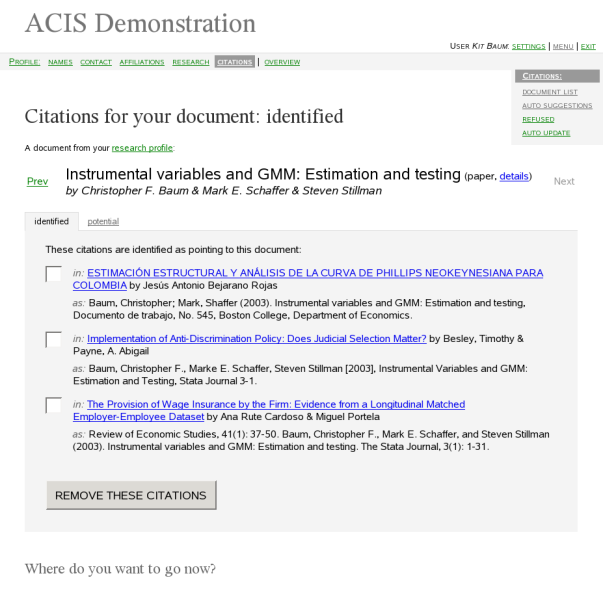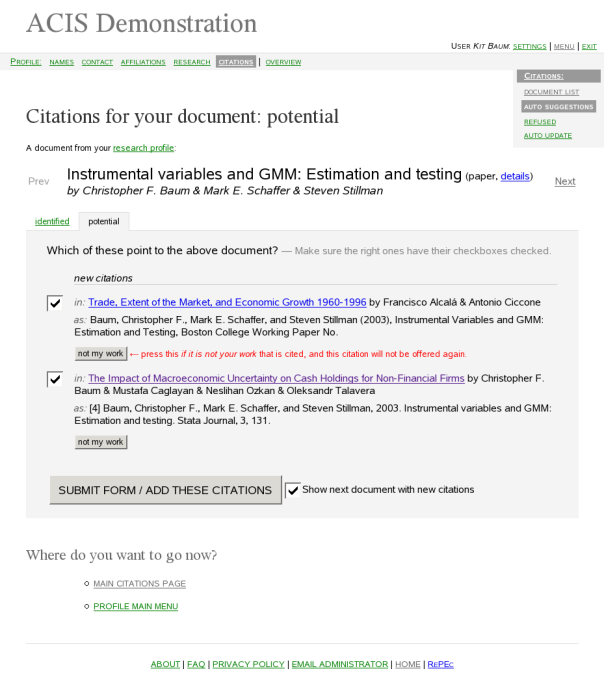
document source in Markdown format


FULLTEXT INDEX (nstring), INDEX (trgdocid)
is a reference to a hash:
{ ostring => CITSTR,
nstring => NORCITSTR }Here CITSTR is the original citation string, and NORCITSTR is the normalized citation string.
is a reference to a hash:
{ title => TITLE,
authors => [ AUTHOR1NAME, AUTHOR2NAME, ... ],
type => TYPE,
location => LOCATION
}Here TITLE is the work's title (a string), AUTHOR1NAME, AUTHOR2NAME and so on are the names of the authors (strings), and TYPE is one of "article", "paper", "book", "software", "chapter", "text" (when no particular type is known).
LOCATION is a string built by joining the following items: the series or journal name, the paper's number in the series (if it is present), the issue/volume/pages. For AMF we can take all the adjectives of the serial adjective container.
foreach ( @names ) {
if ( amatch( $_, $citation ) ) {
$pass = 1;
last;
}
}Each citation item in the userdata is a hash with these items:
- cnid - ostring - srcdocid - srcdoctitle - srcdocauthors - srcdocurlabout - reason (if manually added) - autoaddreason (if automatically added) - autoadded (if automatically added) ### Storing and passing citations around Citations will be stored as: 1. citation table records 2. in-memory suggestions 3. userdata items (see above) Basically, the citations will go from 1 to 2 and from 2 to 3. At each step, some hash keys may be added to a citation or may be removed. But sometimes a citation is removed from userdata and then it may be re-considered as a suggestion (3->2). ### Modules #### ACIS::Citations #### ACIS::Citations::Utils - normalize_string( string ) - build_citations\_index( citlist, [index] ); - build a hash of [ cnid: citation ] pairs ??? - get_document\_authors(); - for co-authors' claims - cit_document\_similarity( cit, doc ) -- default cit-doc similarity func and other useful stuff #### ACIS::Citations::Input use ACIS::Citations::Utils; - process_citation( cit ) - normalize, cut the editors, calculate the checksum - save_citation( cit ) - check_citation( cit ) - reload citation from the citations table or return undef otherwise #### ACIS::Citations::Suggestions #### ACIS::Citations::SimMatrix use ACIS::Citations::Suggestions; exported: - load_similarity\_matrix( record ); - returns matrix structure as specified above object methods: - most\_interesting\_doc( ); - remove_citation( $matrix, $cit ); ... internal: - _calculate_totals( $matrix ); #### ACIS::Citations::Search use ACIS::Citations::Utils; use ACIS::Citations::Suggestions; exportable: - search\_for\_document( id ) - find pre-identified citations - search\_for\_personal\_names( names ) ... #### ACIS::Web::Citations::Profile use ACIS::Citations::Input; use ACIS::Web::SysProfile; #### ACIS::Web::Citations - acis\_citations\_enabled() - check that